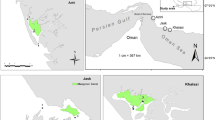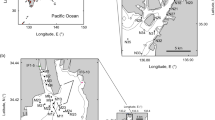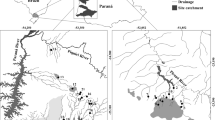Abstract
In accordance with the Water Framework Directive guidelines (WFD, 2000, European Communities Official Journal L327 2000/60/EC), classification schemes and ecological evaluation tools (based on benthic invertebrate fauna data sets from 1990 to 2002) were applied in the lower Mondego estuary. Two distinct scenarios could be tested due to the implementation of mitigation practices in 1999, following a long eutrophication process, which started by the early 1980s. Some discrepancies in the results were found by the application of the different indices. The AMBI index (accounting for taxonomic composition) and the ABC method (accounting for abundance and biomass k-dominance patterns) classifications often disagreed with those based on species diversity (Margalef and Shannon-Wiener). The ambiguous results made the classification a complex task to achieve, contrary to the Directive’s objective of maintaining it simple and clear. Our results suggest the necessity of adjusting some of the indices and their ranges to estuarine characteristics, namely to account the typical dominance and abundance of some particular species. These aspects are not taken into consideration by some of the indices proposed, which are more adapted to typical marine conditions. Based on our results, these widely applied indices might still improve their efficiency in estuarine systems allowing their use in the resembling types already established within the new Directive agenda.


Similar content being viewed by others
References
AZTI, 2004. AZTI tecnalia: investigación marina y alimentaria. http://www.azti.es.
Bellan-Santini, D., 1980. Relationship between populations of amphipods and pollution. Marine Pollution Bulletin 11: 224–227.
Bettencourt, A., S. B. Bricker, J. G. Ferreira, A. Franco, J. C. Marques, J. J. Melo, A. Nobre, L. Ramos, C. S. Reis, F. Salas, M. C. Silva, T. Simas & W. Wolff, 2004. Typology and Reference Conditions for Portuguese Transitional and Coastal Waters. Instituto da Água. Instituto do Mar, Lisbon.
Beukema, J. J., 1988. An evaluation of the ABC-method (abundance/biomass comparison) as applied to macrozoobenthic communities living on tidal flats in the Dutch Wadden Sea. Marine Biology 99: 425–433.
Beukema, J. J., R. Dekker, K. Essink & H. Michaelis, 2001. Synchronized reproductive success of the main bivalve species in the Wadden Sea: causes and consequences. Marine Ecology Progress Series 211: 143–155.
Borja, A., J. Franco & I. Muxika, 2003. Classification Tools for Marine Ecological Quality Assessment: the Usefulness of Macrobenthic Communities in an Area Affected by a Submarine Outfall. ICES C. M. 2003/J:02,. ICES, Copenhagen.
Borja, A., J. Franco & V. Pérez, 2000. A marine biotic index to establish the ecological quality of soft-bottom benthos within European estuarine and coastal environments. Marine Pollution Bulletin 40: 1100–1114.
Borja, A., J. Franco, V. Valencia, J. Bald, I. Muxika, M. J. Belzunce & O. Solaun, 2004. Implementation of the European water framework directive from the Basque country (Northern Spain): a methodological approach. Marine Pollution Bulletin 48: 209–218.
Borja, A. & I. Muxika, 2005. Guidelines for the use of AMBI (AZTI’s Marine Biotic Index) in the assessment of the benthic ecological quality. Marine Pollution Bulletin 50: 787–789.
Boström, C., E. Bonsdorff, P. Kangas & A. Norkko, 2002. Long-term changes of a brackish-water eelgrass (Zostera marina L.) community indicate effects of coastal eutrophication. Estuarine, Coastal and Shelf Science 55: 795–804.
Cardoso, P. G., A. Brandão, M. A. Pardal, D. Raffaelli & J. C. Marques, 2005. Resilience of Hydrobia ulvae populations to anthropogenic and natural disturbances. Marine Ecology Progress Series 289: 191–199.
Cardoso, P. G., M. A. Pardal, A. I. Lillebø, S. M. Ferreira, D. Raffaelli & J. C. Marques, 2004. Dynamic changes in seagrass assemblages under eutrophication and implications for recovery. Journal of Experimental Marine Biology and Ecology 302: 233–248.
Clarke, K. R., 1990. Comparison of dominance curves. Journal of Experimental Marine Biology and Ecology 138: 130–143.
Clarke, K. R. & R. N. Gorley, 2001. PRIMER v5: User Manual/Tutorial. PRIMER-E, Plymouth.
Dauer, D. M., M. W. Luckenbach & A. J. Rodi Jr., 1993. Abundance biomass comparison (ABC method): effects of an estuarine gradient, anoxic/hypoxic events and contaminated sediments. Marine Biology 116: 507–518.
Diaz, R. J., M. Solan & R. M. Valente, 2004. A review of approaches for classifying benthic habitats and evaluating habitat quality. Journal of Environmental Management 73: 165-181.
Dolbeth, M., M. A. Pardal, A. I. Lillebø, U. Azeiteiro & J. C. Marques, 2003. Short- and long-term effects of eutrophication on the secondary production of an intertidal macrobenthic community. Marine Biology 143: 1229–1238.
Margalef, R., 1968. Perspectives in Ecological Theory. University of Chicago Press, Illinois.
Marques, J. C., P. Maranhão & M. A. Pardal, 1993. Human impact on the subtidal macrobenthic community structure in the Mondego estuary (Western Portugal). Estuarine, Coastal and Shelf Science 37: 403–419.
Marques, J. C., S. N. Nielsen, M. A. Pardal & S. E. Jørgensen, 2003. Impact of eutrophication and river management within a framework of ecosystem theories. Ecological Modelling 166: 147–168.
McLusky, D. S., 1990. The Estuarine Ecosystem. 2nd edn. Chapman & Hall, New York.
Molvær, J., J. Knutzen, J. Magnusson, B. Rygg, J. Skei & J. Sørensen, 1997. Classification of environmental quality in fjords and coastal waters. SFT Guidelines 97:03. Norwegian Pollution Control Authority, Oslo.
Muxika, I., A. Borja & W. Bonne, 2005. The suitability of the marine biotic index (AMBI) to new impact sources along European coasts. Ecological Indicators 5: 19–31.
NEAGIG Invertebrate Group, 2004. Minutes of Northeast Atlantic Geographical Intercalibration Group. Benthic Expert Meeting. Kristineberg Marine Station, Sweden.
Pardal, M. A., P. G Cardoso, J. P. Sousa, J. C. Marques & D. Raffaelli, 2004. Assessing environmental quality: a novel approach. Marine Ecology Progress Series 267: 1–8.
Prior, A., A. C. Miles, A. J. Sparrow & N. Price, 2004. Development of a classification scheme for the marine benthic invertebrate component, water framework directive. Phase I & II. Transitional and coastal waters. R & D Interim Technical Report.
Rodrigues, E., 2004. Variação das comunidades macrobentónicas subtidais do estuário do Mondego ao longo de mais de uma década. (Master Thesis). Universidade de Coimbra, Coimbra.
Ros, J. D. & M. J. Cardell, 1991. La diversidad específica y otros descriptores de contaminación orgánica en comunidades bentónicas marinas. Actas del symposium sobre diversidad biológica. Centro de Estudios Ramón Areces, Madrid: 219–223.
Schlacher, T. A. & T. H. Wooldridge, 1996. How sieve mesh size affects sample estimates of estuarine benthic macrofauna. Journal of Experimental Marine Biology and Ecology 201: 159–171.
Shannon, C. E. & W. Weaver, 1963. The Mathematical Theory of Communication. The University of Illinois Press, Illinois.
Strasser, M., R. Dekker, K. Essink, C.-P. Günther, S. Jaklin, I. Krönke, P. B. Madsen, H. Michaelis & G. Vedel, 2003. How predictable is excellent bivalve recruitment in the Wadden Sea after a severe winter? Journal of Sea Research 49: 47–57.
Thompson, B. W., M. J. Riddle & J. S. Stark, 2003. Cost-efficient methods for marine pollution monitoring at Casey Station, East Antarctica: the choice of sieve mesh-size and taxonomic resolution. Marine Pollution Bulletin 46: 232–243.
Verdelhos, T., J. M. Neto, J. C. Marques & M. A. Pardal, 2005. The effect of eutrophication abatement on the bivalve Scrobicularia plana. Estuarine, Coastal and Shelf Science 63: 261–268.
Warwick, R. M., 1986. A new method for detecting pollution effects on marine macrobenthic communities. Marine Biology 92: 557–562.
Warwick, R. M., 1993. Environmental impact studies on marine communities: pragmatical considerations. Australian Journal of Ecology 18: 63–80.
Warwick, R. M. & K. R. Clarke, 1994. Relearning the ABC: taxonomic changes and abundance/biomass relationships in disturbed benthic communities. Marine Biology 118: 739–744.
Water Framework Directive, 2000. European Communities Official Journal L327, 2000/60/EC: 1-72.
Wilson, J. G. & B. Elkaïm, 1992. Estuarine bioindicators: a case for caution. Acta Oecologica 13: 345–358.
Ysebaert, T., P. M. J. Herman, P. Meire, J. Craeymeersch, H. Verbeek & C. H. R. Heip, 2003. Large-scale spatial patterns in estuaries: estuarine macrobenthic communities in the Schelde estuary, NW Europe. Estuarine, Coastal and Shelf Science 57: 335–355.
Zacharias, M. A., M. C. Morris & D. E. Howes, 1999. Large scale characterization of intertidal communities using a predictive model. Journal of Experimental Marine Biology and Ecology 239: 223–242.
Acknowledgements
The present study was carried out in the scope of the research project Typology and Reference Conditions for Transitional and Coastal Portuguese Waters—TICOR, funded by INAG—Instituto da Água (Portugal), and Dynamic model of stress induced changes on benthic communities—DYNAMOD (POCTI/MGS/37431/2001), funded by FCT (Portuguese National Board of Scientific Research).
Author information
Authors and Affiliations
Corresponding author
Rights and permissions
About this article
Cite this article
Teixeira, H., Salas, F., Pardal, M.A. et al. Applicability of ecological evaluation tools in estuarine ecosystems: the case of the lower Mondego estuary (Portugal). Hydrobiologia 587, 101–112 (2007). https://doi.org/10.1007/s10750-007-0697-3
Issue Date:
DOI: https://doi.org/10.1007/s10750-007-0697-3




